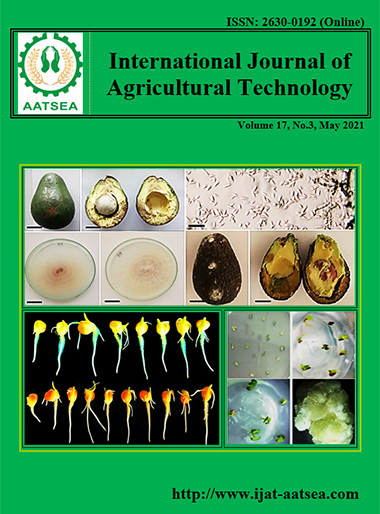Sediment accumulation rate and carbon burial rate in the Pacific white shrimp (Litopenaeus vannamei) ponds, Phetchaburi Province, upper Gulf of Thailand
Main Article Content
Abstract
Sediment accumulation rate and carbon burial rate in Pacific white shrimp ponds was reported. The results can be helpful for the sediment quality management during crop to get the high productivity of both marketable species and to make the environment sustainable. The sediment accumulation rate and carbon burial rate were studied at shrimp farm in Phetchaburi Province, upper Gulf of Thailand. The two ponds were sampled every two weeks for one crop. The most sediment quality parameters were appropriated standard criteria. However, at the end of the crop, total nitrogen and organic carbon were higher than other periods (p<0.05) and higher than standard criteria. It indicated that the amount of accumulated waste in the ponds increased with enhancing culture periods. The sediment depth had a high level of positive correlation (p<0.05) with total nitrogen (r=0.965), total phosphorus (r=0.785) and organic carbon (r=0.817). The results indicated that the nutrient and waste increased along the culture periods and the highest amount during the harvesting period. The averaged data of sediment accumulation rate were 21.50±2.95 cm·yr-1 and the averaged data of carbon burial rate in the Pacific white shrimp ponds in study area were 51.94±26.55 g C·m2·yr-1
Article Details

This work is licensed under a Creative Commons Attribution-NonCommercial-NoDerivatives 4.0 International License.
References
Adhikari, S., Lal, R. and Sahu, B. C. (2012). Carbon sequestration in the bottom sediments of aquaculture ponds of Orissa, India. Ecological Engineering, 47:198-202.
Avnimelech, Y., Ritvo, G., Meijer, L. E. and Kochba, M. (2001). Water content, organic carbon and dry bulk density in flooded sediments. Aquacultural Engineering, 25:25-33.
Black, C. A. (1965). Methods of Soil Analysis: Part I, Physical and Mineralogical Properties. American Society of Agronomy, Madison, 1572 p.
Blake, G. R. and Hartge, K. H. (1986). Bulk density. American Society of Agronomy, Madison, pp.363-375.
Boyd, C. E. (1995). Bottom soils, sediment and pond aquaculture. Department of Fisheries and Allied Aquacultures, Auburn University, Boston, Springer, 348 p.
Boyd, C. E. (2008). Pond Bottom Soil Analyses. Retrieved from https://www.aquaculturealliance.org/advocate/pond-bottom-soil-analyses/
Boyd, C. E., Wood, C. W. and Thunjai, T. (2002). Aquaculture Pond Bottom Soil Quality Management. Pond Dynamics/Aquaculture Collaborative Research Support Program. Oregon State University, Corvallis, 38 p.
Boyd, C. E., Wood, C. W., Chaney, P. L. and Queiroz, J. F. (2010). Role of aquaculture pond sediments in sequestration of annual global carbon emissions. Environmental Pollution, 158:2537-2540.
Bremner, J. M. and Mulvaney, C. S. (1982). Nitrogen-Total. In: Page A. L. (ed.). Methods of Soil Analysis, Part 2, American Society of Agronomy, Madison, pp.595-624.
Chen, G., Chen, J., Ou, D., Tam, N. F. Y., Chen, S., Zhang, Q., Chen, B. and Ye, Y. (2020). Increased nitrous oxide emissions from intertidal soil receiving wastewater from dredging shrimp pond sediments. Environmental Research Letters, 15:1-10.
Egna, H. S. and Boyd, C. E. (1997). Dynamic of Pond Aquaculture. New York, 472 p.
Naylor, R. and Burke, M. (2005). Aquaculture and ocean resources: raising tigers of the sea. Annual Review Environment Resources, 30:185-218.
Nelson, D. W. and Sommers, L. E. (1982). Total carbon, organic carbon, and organic matter. In: Page A. L., Miller, R. H. and Keeney, D. R. (eds.). Method of Soil Analysis, Part 2, American Society of Agronomy, Madison, pp.539-579.
Olsen, S. R. and Sommers, L. E. (1982). Phosphorus. In: Page Miller, R.H. and Keeney, D.R. (eds.). Method of Soil Analysis, Part 2, American A.L., Society of Agronomy, Madison, pp.403-427.
Páez-Osuna, F. (2001). The environmental impact of shrimp aquaculture: Causes, Effects, and Mitigating alternatives. Environmental Management, 28:131-140.
Pawar, V., Matsuda, O. and Fujisaki, N. (2002). Relationship between feed input and sediment quality of the fish cage farms. Fisheries science, 68:894-903.
Pawar, V., Matsuda, O., Yamamoto, T., Hashimoto, T. and Rajendran, N. (2001). Spatial and temporal variations of sediment quality in and around fish cage farms: A case study of aquaculture in the Seto Inland Sea, Japan. Fisheries science, 67:619-627.
Steeby, J. A., Hargreaves, J. A., Tucker, C. S. and Kingsbury, S. (2004). Accumulation, organic carbon and dry matter concentration of sediment in commercial channel catfish ponds. Aquaculture Engineering, 30:115-126.
Thunjai, T., Boyd, C. E. and Dube, K. (2001). Pond soil pH measurement. Journal of the World Aquaculture Society, 32:141-152.
Tsutsumi, H., Kikuchi, T., Tanaka, M., Higashi, T., Imasaka, K. and Miyazaki, M. (1991). Benthic faunal succession in a cove organically polluted by fish farming. Marine Pollution Bulletin, 23:233-238.
Weber, J. B. (1977). Soil properties, herbicide sorption, and model soil systems. In: Truelove, B.Jr. (ed.). Research method in weed science, Southern Weed Science Society, Auburn, pp.59-62.
Wu, H., Peng, R., Yang, Y., He, L., Wang, W., Zheng, T. and Lin, G. (2014). Mariculture pond influence on mangrove areas in south China: significantly larger nitrogen and phosphorus loadings from sediment wash-out than from tidal water exchange. Aquaculture, 426-427:204-212.
Xing Y., Xie, P., Yang, H., Y., Ni, L., Wang, Y. and Rong, K. (2005). Methane and carbon dioxide fluxes from a shallow hypereutrophic subtropical Lake in China. Atmospheric Environment, 39:5532-5540.


